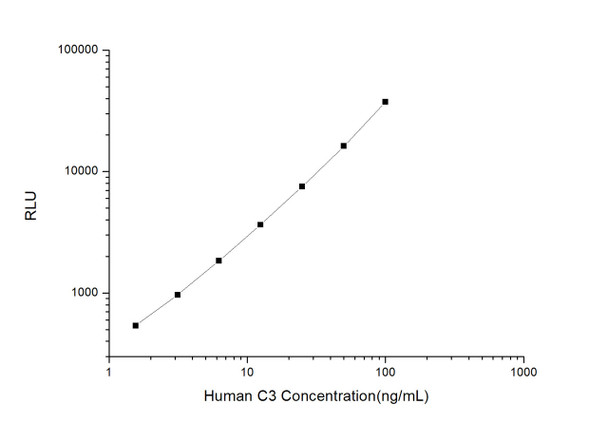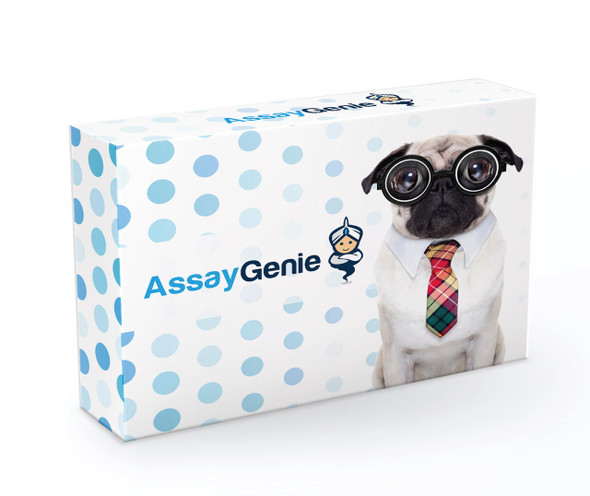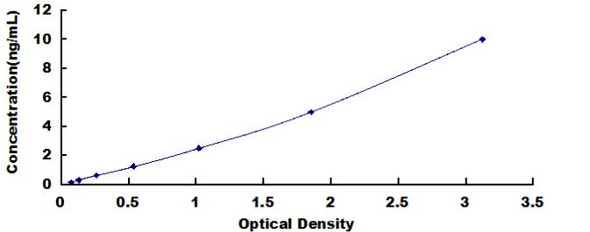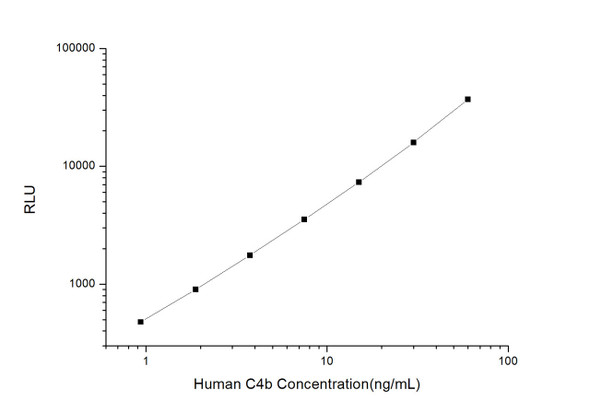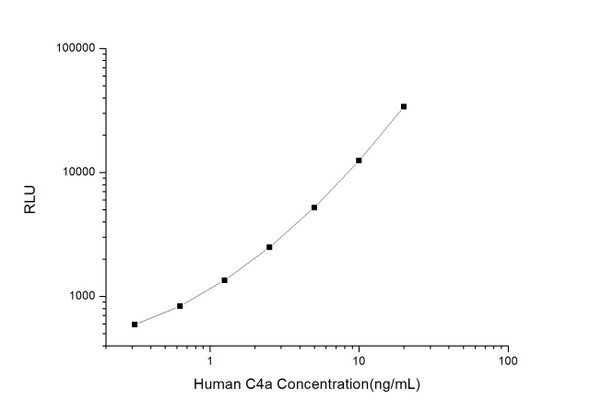Human Immunology ELISA Kits 1
Human C3 (Complement Component 3) CLIA Kit (HUES00501)
- SKU:
- HUES00501
- Product Type:
- ELISA Kit
- ELISA Type:
- CLIA Kit
- Size:
- 96 Assays
- Sensitivity:
- 0.94ng/mL
- Range:
- 1.56-100ng/mL
- ELISA Type:
- Sandwich
- Synonyms:
- ASP, CPAMD1, AHUS5, ARMD9, C3a, C3b
- Reactivity:
- Human
- Sample Type:
- Serum, plasma and other biological fluids
- Research Area:
- Immunology
Description
| Assay type: | Sandwich |
| Format: | 96T |
| Assay time: | 4.5h |
| Reactivity: | Human |
| Detection method: | Chemiluminescence |
| Detection range: | 1.56-100 ng/mL |
| Sensitivity: | 0.94 ng/mL |
| Sample volume: | 100µL |
| Sample type: | Serum, plasma and other biological fluids |
| Repeatability: | CV < 15% |
| Specificity: | This kit recognizes Human C3 in samples. No significant cross-reactivity or interference between Human C3 and analogues was observed. |
This kit uses Sandwich-CLIA as the method. The micro CLIA plate provided in this kit has been pre-coated with an antibody specific to Human C3. Standards or samples are added to the appropriate micro CLIA plate wells and combined with the specific antibody. Then a biotinylated detection antibody specific for Human C3 and Avidin-Horseradish Peroxidase (HRP) conjugate are added to each micro plate well successively and incubated. Free components are washed away. The substrate solution is added to each well. Only those wells that contain Human C3, biotinylated detection antibody and Avidin-HRP conjugate will appear fluorescence. The Relative light unit (RLU) value is measured spectrophotometrically by the Chemiluminescence immunoassay analyzer. The RLU value is positively associated with the concentration of Human C3. The concentration of Human C3 in the samples can be calculated by comparing the RLU of the samples to the standard curve.
| UniProt Protein Function: | C3: C3 plays a central role in the activation of the complement system. Its processing by C3 convertase is the central reaction in both classical and alternative complement pathways. After activation C3b can bind covalently, via its reactive thioester, to cell surface carbohydrates or immune aggregates. Defects in C3 are the cause of complement component 3 deficiency (C3D). A rare defect of the complement classical pathway. Patients develop recurrent, severe, pyogenic infections because of ineffective opsonization of pathogens. Some patients may also develop autoimmune disorders, such as arthralgia and vasculitic rashes, lupus-like syndrome and membranoproliferative glomerulonephritis. Genetic variation in C3 is associated with susceptibility to age-related macular degeneration type 9 (ARMD9). ARMD is a multifactorial eye disease and the most common cause of irreversible vision loss in the developed world. In most patients, the disease is manifest as ophthalmoscopically visible yellowish accumulations of protein and lipid that lie beneath the retinal pigment epithelium and within an elastin- containing structure known as Bruch membrane. Defects in C3 are a cause of susceptibility to hemolytic uremic syndrome atypical type 5 (AHUS5). An atypical form of hemolytic uremic syndrome. It is a complex genetic disease characterized by microangiopathic hemolytic anemia, thrombocytopenia, renal failure and absence of episodes of enterocolitis and diarrhea. In contrast to typical hemolytic uremic syndrome, atypical forms have a poorer prognosis, with higher death rates and frequent progression to end-stage renal disease. Susceptibility to the development of atypical hemolytic uremic syndrome can be conferred by mutations in various components of or regulatory factors in the complement cascade system. Other genes may play a role in modifying the phenotype. Increased levels of C3 and its cleavage product ASP, are associated with obesity, diabetes and coronary heart disease. Short-term endurance training reduces baseline ASP levels and subsequently fat storage. |
| UniProt Protein Details: | Protein type:Secreted, signal peptide; Inhibitor; Secreted Chromosomal Location of Human Ortholog: 19p13. 3-p13. 2 Cellular Component: extracellular space; extracellular region; plasma membrane Molecular Function:protein binding; endopeptidase inhibitor activity; C5L2 anaphylatoxin chemotactic receptor binding; receptor binding Biological Process: regulation of immune response; complement activation, alternative pathway; signal transduction; fatty acid metabolic process; complement activation; G-protein coupled receptor protein signaling pathway; positive regulation of angiogenesis; positive regulation of activation of membrane attack complex; positive regulation of type IIa hypersensitivity; positive regulation of G-protein coupled receptor protein signaling pathway; regulation of complement activation; innate immune response; immune response; positive regulation of protein amino acid phosphorylation; inflammatory response; complement activation, classical pathway Disease: Complement Component 3 Deficiency, Autosomal Recessive; Hemolytic Uremic Syndrome, Atypical, Susceptibility To, 5; Macular Degeneration, Age-related, 9 |
| NCBI Summary: | Complement component C3 plays a central role in the activation of complement system. Its activation is required for both classical and alternative complement activation pathways. A peptide (C3a) derived from the encoded protein has antimicrobial activity, so people with C3 deficiency are susceptible to bacterial infection. [provided by RefSeq, Nov 2014] |
| UniProt Code: | P01024 |
| NCBI GenInfo Identifier: | 119370332 |
| NCBI Gene ID: | 718 |
| NCBI Accession: | P01024. 2 |
| UniProt Secondary Accession: | P01024,A7E236, |
| UniProt Related Accession: | P01024 |
| Molecular Weight: | |
| NCBI Full Name: | Complement C3 |
| NCBI Synonym Full Names: | complement component 3 |
| NCBI Official Symbol: | C3 |
| NCBI Official Synonym Symbols: | ASP; C3a; C3b; AHUS5; ARMD9; CPAMD1; HEL-S-62p |
| NCBI Protein Information: | complement C3; prepro-C3; C3a anaphylatoxin; complement component C3; complement component C3a; complement component C3b; acylation-stimulating protein cleavage product; epididymis secretory sperm binding protein Li 62p; C3 and PZP-like alpha-2-macroglobulin domain-containing protein 1 |
| UniProt Protein Name: | Complement C3 |
| UniProt Synonym Protein Names: | C3 and PZP-like alpha-2-macroglobulin domain-containing protein 1Cleaved into the following 12 chains:Complement C3 beta chain; C3-beta-c; C3bc; Complement C3 alpha chain; C3a anaphylatoxin; Acylation stimulating protein; ASPAlternative name(s):C3adesArg |
| Protein Family: | Complement C3 |
| UniProt Gene Name: | C3 |
| UniProt Entry Name: | CO3_HUMAN |
As the RLU values of the standard curve may vary according to the conditions of the actual assay performance (e. g. operator, pipetting technique, washing technique or temperature effects), the operator should establish a standard curve for each test. Typical standard curve and data is provided below for reference only.
| Concentration (ng/mL) | RLU | Average | Corrected |
| 100 | 33806 41302 | 37554 | 37521 |
| 50 | 14781 17701 | 16241 | 16208 |
| 25 | 7808 7276 | 7542 | 7509 |
| 12.5 | 3388 3976 | 3682 | 3649 |
| 6.25 | 2007 1743 | 1875 | 1842 |
| 3.13 | 1036 966 | 1001 | 968 |
| 1.56 | 557 587 | 572 | 539 |
| 0 | 32 34 | 33 | -- |
Precision
Intra-assay Precision (Precision within an assay): 3 samples with low, mid range and high level Human C3 were tested 20 times on one plate, respectively.
Inter-assay Precision (Precision between assays): 3 samples with low, mid range and high level Human C3 were tested on 3 different plates, 20 replicates in each plate.
| Intra-assay Precision | Inter-assay Precision | |||||
| Sample | 1 | 2 | 3 | 1 | 2 | 3 |
| n | 20 | 20 | 20 | 20 | 20 | 20 |
| Mean (ng/mL) | 5.12 | 13.59 | 38.98 | 5.24 | 12.56 | 38.79 |
| Standard deviation | 0.45 | 1.37 | 3.27 | 0.43 | 0.97 | 3.13 |
| C V (%) | 8.79 | 10.08 | 8.39 | 8.21 | 7.72 | 8.07 |
Recovery
The recovery of Human C3 spiked at three different levels in samples throughout the range of the assay was evaluated in various matrices.
| Sample Type | Range (%) | Average Recovery (%) |
| Serum (n=5) | 92-110 | 100 |
| EDTA plasma (n=5) | 97-109 | 103 |
| Cell culture media (n=5) | 90-100 | 95 |
Linearity
Samples were spiked with high concentrations of Human C3 and diluted with Reference Standard & Sample Diluent to produce samples with values within the range of the assay.
| Serum (n=5) | EDTA plasma (n=5) | Cell culture media (n=5) | ||
| 1:2 | Range (%) | 89-104 | 101-112 | 103-115 |
| Average (%) | 96 | 106 | 109 | |
| 1:4 | Range (%) | 99-110 | 95-110 | 99-115 |
| Average (%) | 105 | 101 | 106 | |
| 1:8 | Range (%) | 90-101 | 93-104 | 94-109 |
| Average (%) | 96 | 99 | 99 | |
| 1:16 | Range (%) | 95-110 | 94-108 | 85-96 |
| Average (%) | 102 | 101 | 90 |
An unopened kit can be stored at 4°C for 1 month. If the kit is not used within 1 month, store the items separately according to the following conditions once the kit is received.
| Item | Specifications | Storage |
| Micro CLIA Plate(Dismountable) | 8 wells ×12 strips | -20°C, 6 months |
| Reference Standard | 2 vials | |
| Concentrated Biotinylated Detection Ab (100×) | 1 vial, 120 µL | |
| Concentrated HRP Conjugate (100×) | 1 vial, 120 µL | -20°C(shading light), 6 months |
| Reference Standard & Sample Diluent | 1 vial, 20 mL | 4°C, 6 months |
| Biotinylated Detection Ab Diluent | 1 vial, 14 mL | |
| HRP Conjugate Diluent | 1 vial, 14 mL | |
| Concentrated Wash Buffer (25×) | 1 vial, 30 mL | |
| Substrate Reagent A | 1 vial, 5 mL | 4°C (shading light) |
| Substrate Reagent B | 1 vial, 5 mL | 4°C (shading light) |
| Plate Sealer | 5 pieces | |
| Product Description | 1 copy | |
| Certificate of Analysis | 1 copy |
- Set standard, test sample and control (zero) wells on the pre-coated plate and record theirpositions. It is recommended to measure each standard and sample in duplicate. Note: addall solutions to the bottom of the plate wells while avoiding contact with the well walls. Ensuresolutions do not foam when adding to the wells.
- Aliquot 100µl of standard solutions into the standard wells.
- Add 100µl of Sample / Standard dilution buffer into the control (zero) well.
- Add 100µl of properly diluted sample (serum, plasma, tissue homogenates and otherbiological fluids. ) into test sample wells.
- Cover the plate with the sealer provided in the kit and incubate for 90 min at 37°C.
- Aspirate the liquid from each well, do not wash. Immediately add 100µL of BiotinylatedDetection Ab working solution to each well. Cover the plate with a plate seal and gently mix. Incubate for 1 hour at 37°C.
- Aspirate or decant the solution from the plate and add 350µL of wash buffer to each welland incubate for 1-2 minutes at room temperature. Aspirate the solution from each well andclap the plate on absorbent filter paper to dry. Repeat this process 3 times. Note: a microplatewasher can be used in this step and other wash steps.
- Add 100µL of HRP Conjugate working solution to each well. Cover with a plate seal andincubate for 30 min at 37°C.
- Aspirate or decant the solution from each well. Repeat the wash process for five times asconducted in step 7.
- Add 100µL of Substrate mixture solution to each well. Cover with a new plate seal andincubate for no more than 5 min at 37°C. Protect the plate from light.
- Determine the RLU value of each well immediately.

